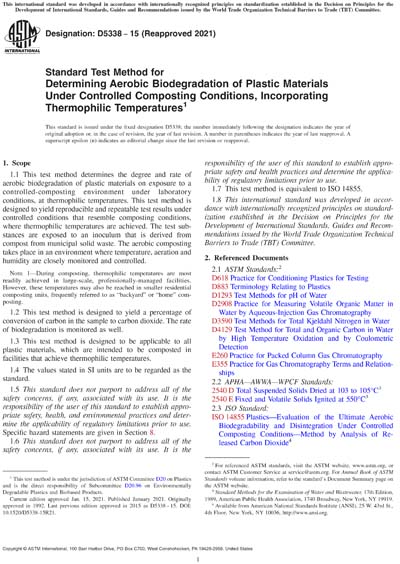Most recent
ASTM D5338-15(2021)
Standard Test Method for Determining Aerobic Biodegradation of Plastic Materials Under Controlled Composting Conditions, Incorporating Thermophilic Temperatures
1.1 This test method determines the degree and rate of aerobic biodegradation of plastic materials on exposure to a controlled-composting environment under laboratory conditions, at thermophilic temperatures. This test method is designed to yield reproducible and repeatable test results under controlled conditions that resemble composting conditions, where thermophilic temperatures are achieved. The test substances are exposed to an inoculum that is derived from compost from municipal solid waste. The aerobic composting takes place in an environment where temperature, aeration and humidity are closely monitored and controlled.
Note 1: During composting, thermophilic temperatures are most readily achieved in large-scale, professionally-managed facilities. However, these temperatures may also be reached in smaller residential composting units, frequently referred to as “backyard†or “home†composting.
1.2 This test method is designed to yield a percentage of conversion of carbon in the sample to carbon dioxide. The rate of biodegradation is monitored as well.
1.3 This test method is designed to be applicable to all plastic materials, which are intended to be composted in facilities that achieve thermophilic temperatures.
1.4 The values stated in SI units are to be regarded as the standard.
1.5 This standard does not purport to address all of the safety concerns, if any, associated with its use. It is the responsibility of the user of this standard to establish appropriate safety, health, and environmental practices and determine the applicability of regulatory limitations prior to use. Specific hazard statements are given in Section 8.
1.6 This standard does not purport to address all of the safety concerns, if any, associated with its use. It is the responsibility of the user of this standard to establish appropriate safety and health practices and determine the applicability of regulatory limitations prior to use.
1.7 This test method is equivalent to ISO 14855.
1.8 This international standard was developed in accordance with internationally recognized principles on standardization established in the Decision on Principles for the Development of International Standards, Guides and Recommendations issued by the World Trade Organization Technical Barriers to Trade (TBT) Committee.
ASTM International [astm]

